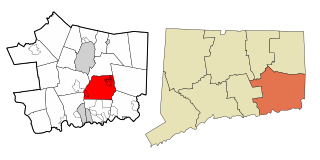
Ledyard is a Town in New London County, Connecticut, United States, located along the Thames River. The town is named after Colonel William Ledyard, a Revolutionary War officer who was killed at the Battle of Groton Heights. The population was 15,413 at the 2020 census. The Foxwoods Resort Casino, owned and operated by the Mashantucket Pequot Tribe, is located in the northeastern section of Ledyard, on the reservation owned by the tribe.
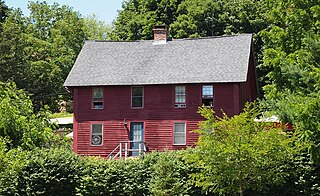
The Quaker Hill Historic District encompasses the center a mainly residential village in northeastern Waterford, Connecticut. Running in a mostly linear fashion along Old Norwich Road between Connecticut Route 32 and Richard Grove Road, the area first grew as a settlement of religious non-conformists in the 17th century, developed in the 19th century as a small industrial village, and became more suburban in character in the 20th century. Its architecture is reflective of these changes, and it was listed on the National Register of Historic Places in 2002.

Burnetts Corner is a village in the town of Groton, Connecticut, and the site of Burnett's Corner Historic District, a historic district listed on the National Register of Historic Places.

East Windsor Hill Historic District is a historic district located in the northwestern corner of the town of South Windsor, Connecticut. It was listed on the National Register of Historic Places in 1986. The district runs along both sides of Main Street from the Scantic River south to the Edwards Cemetery. The district also includes areas west of Main Street to the Connecticut River, including properties along Ferry Lane. The district is located directly north of another historic district, Windsor Farms Historic District. The district encompasses a neighborhood of well-preserved largely folk vernacular buildings erected between about 1700 and 1860.

Cannondale Historic District is a historic district in the Cannondale section in the north-central area of the town of Wilton, Connecticut. The district includes 58 contributing buildings, one other contributing structure, one contributing site, and 3 contributing objects, over a 202 acres (82 ha). About half of the buildings are along Danbury Road and most of the rest are close to the Cannondale train station .The district is significant because it embodies the distinctive architectural and cultural-landscape characteristics of a small commercial center as well as an agricultural community from the early national period through the early 20th century....The historic uses of the properties in the district include virtually the full array of human activity in this region—farming, residential, religious, educational, community groups, small-scale manufacturing, transportation, and even government. The close physical relationship among all these uses, as well as the informal character of the commercial enterprises before the rise of more aggressive techniques to attract consumers, capture some of the texture of life as lived by prior generations. The district is also significant for its collection of architecture and for its historic significance.
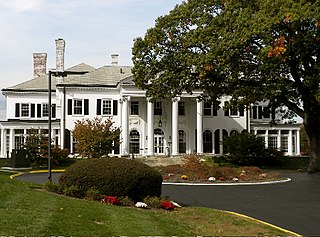
The Prospect Hill Historic District is an irregularly-shaped 185-acre (75 ha) historic district in New Haven, Connecticut. The district encompasses most of the residential portion of the Prospect Hill neighborhood.

The Dwight Street Historic District is an irregularly shaped 135-acre (55 ha) historic district in New Haven, Connecticut. The district is located immediately west of the center of Downtown New Haven and is generally bounded by Elm Street on the north, Park Street on the east, North Frontage Road on the south, and Sherman Avenue on the west. It contains one of the city's highest concentrations of well-preserved 19th and early 20th-century residential architecture, much of which was developed for the working classes in the city's factories. It was listed on the National Register of Historic Places in 1983. The historic district includes most of the Dwight neighborhood and several blocks of the northeast corner of the West River neighborhood.

The Graniteville Historic District is a mainly residential historic district in Waterford, Connecticut. It is ranged along Rope Ferry Road, near granite quarries that were once a major industry in the town. Most of the 31 historical buildings in the district are plain residences occupied by quarry workers; also included are the c. 1878 Graniteville School at 239 Rope Ferry Road, and the house of John Palmer, one of the proprietors of the quarries, at 218 Rope Ferry Road. His house, a c. 1860 Italianate updating of an older house, is the most elaborate house in the district. The district was listed on the National Register of Historic Places in 2003.
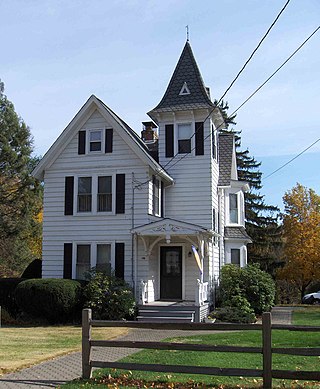
Marion is a neighborhood in the town of Southington in Hartford County, Connecticut, United States. It is generally the area in the vicinity of the intersection of Route 322 and Marion Avenue just north of the Cheshire town line.

The Nathan Lester House is a historic house museum at 153 Vinegar Hill Road in the Gales Ferry section of Ledyard, Connecticut. Built in 1793, it is a well-preserved example of an unpretentious late 18th-century farmhouse, and one of the few houses of that age left in the town. It is located on over {{convert|156 acres of land, now owned by the town, which serves as a park and conservation land with trails.
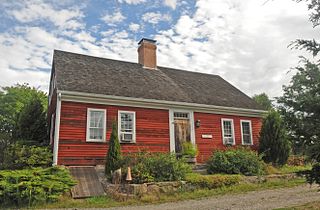
The Capt. Mark Stoddard Farmstead is a historic house at 24 Vinegar Hill Road in the Gales Ferry section of Ledyard, Connecticut. Built about 1770, it is a well-preserved example of a rural Cape style farmhouse, whose preservation includes its remote rural setting. The property was listed on the National Register of Historic Places in 1992.

The Main Sawmill, now known as Ledyard Up-Down Sawmill, is a historic 19th-century sawmill at 175 Iron Street in Ledyard, Connecticut. The sawmill was built in 1869 by Israel Brown, and is the only known operational mill of this type in the state. It was listed on the National Register of Historic Places in 1972. It is now owned by the town and administered by the local historical society as a museum.

The Haviland and Elizabeth Streets–Hanford Place Historic District is an irregularly shaped 4.3-acre (1.7 ha) historic district in Norwalk, Connecticut that was listed on the National Register of Historic Places in 1988. It encompasses a neighborhood that developed in the late 19th century following the introduction of railroad service to South Norwalk.

The Terry's Plain Historic District is a 325-acre (132 ha) historic district in the town of Simsbury, Connecticut that was listed on the National Register of Historic Places in 1993. The district is significant as a preserved rural landscape. It included 27 contributing buildings of various architectural styles, including Greek Revival, Federal and Late Victorian architecture, and 17 non-contributing buildings.

The Spring Hill Historic District encompasses a rural 19th-century village stretching along Storrs Road in Mansfield, Connecticut. Spring Hill developed as a rural waystation on an early 19th-century turnpike, and has seen only modest development since the late 19th century. The district was listed on the National Register of Historic Places in 1979.

The Shubel Smith House, also known as Stonecroft, is a historic house at 515 Pumpkin Hill Road in Ledyard, Connecticut. It was built in 1807 as the estate of Shubel Smith, a sea captain, and is one of Ledyard's finest surviving farmhouses from that period. It was listed on the National Register of Historic Places in 1996. The listing included three contributing buildings on a 6.5-acre (2.6 ha) area, including the Georgian Colonial house and the "Yellow Barn" as well as a smaller outbuilding. Both of the large buildings have modernized interiors, serving as a bed and breakfast called Stonecroft Country Inn.

The Edward L. Burnham Farm is a historic farmstead at 580 Burnham Street West in Manchester, Connecticut. Built in 1861, the house is a well preserved example of a vernacular Greek Revival farmhouse. It was built for a locally prominent family that had farmed the surrounding land for generations. The house was listed on the National Register of Historic Places in 1982.

The David Chapman Farmstead is a historic house at 128 Stoddards Wharf Road in Ledyard, Connecticut. Built about 1744, it is a well-preserved example of a vernacular rural farmhouse of the period, built by a descendant of one of Ledyard's early settlers. It was listed on the National Register of Historic Places in 1992.

The Capt. Thomas Fanning Farmstead is a historic farm property at 1004 Shewville Road in Ledyard, Connecticut. With a building history dating to about 1746, it is one of the oldest surviving agricultural properties in the town, including the house, barn, and smaller outbuildings. The property, now reduced to 4 acres (1.6 ha), was listed on the National Register of Historic Places in 1992.

The William Noyes Farmstead is a historic farm property at 340 Gallup Hill Road in Ledyard, Connecticut. Dating to about 1735, it is a well-preserved example of a rural farmstead. It was listed on the National Register of Historic Places in 1992.



























